Cathedrals, Colonization, and Conversion: Mapping the Music of New Spain
New Spain was a vast geographical area spanning from modern-day Texas through Mexico, reaching Central America. The period of activity we are looking at began in 1521 with the fall of the Aztec Empire to Spanish forces, and ended in 1821, when Mexico claimed its independence from Old Spain.
Researching music from a large timeline and geographical area required us to make some important decisions very early on. Early in our brainstorming process, we realized that there was no way we could possibly cover everything about music in New Spain from 1521 to 1821. So, we started asking questions: What were the most important things to know? What information would be of interest and importance to our audience? What information is accessible to us at this time? Narrowing our research focus was the first step, and we decided to focus on a few different aspects of music in New Spain, including mission songs, cathedral music, and villancicos.
Our Process
Our research process is still incomplete, and there are many sources that are out of our reach. For example, there are many original manuscripts that have been lost or are now […]
The Scholars
An important aspect of our research process was connecting with some of the actual scholars themselves: Drew Edward Davies and Kristin Dutcher Mann […]
The Caveats
Our research covered a wide range of genres, locations, and time periods, which naturally left us without much depth. To some extent, the shallowness of our research […]
Our Maps
These maps, which are a visual presentation of our research, combine the different aspects that we looked at during our research. We wanted to show the spatial relationship between indigenous territories, cathedrals, and missions.
The basemap consists of the world map in grayscale as well as the areas of two Indigenous empires, colored in light green: the Aztec empire and the Incan empire. There are a lot of other native lands that we did not include here, which we also need to acknowledge. For a clean visual presentation, we decided to eliminate some data and keep what is most relevant to the development of cathedrals in New Spain. Cathedrals, missions and chapel masters are all represented by different shapes on the map.
The missions are marked in yellow diamond shapes, and the chapel masters are color-coded to illustrate the origin points (in Europe) and destination points (in New Spain) of each chapel master. It is clearly shown that the cathedrals and mission are located in separate parts of the territory, and the chapel masters are located closer to the cathedrals.
In the future, there could be lines drawn on the map, indicating the actual routes of individual chapel masters. This research project has the potential to be bigger, more specific and better presented, but the map we are presenting is a gateway to further study with an appropriate amount of data.
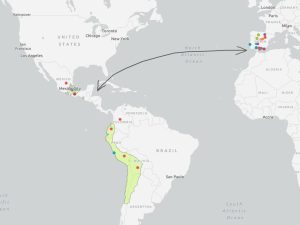
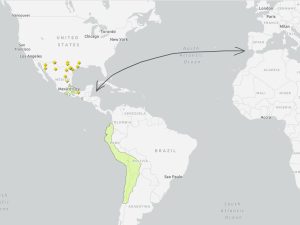

The leftmost map shows the origin places (generally in Europe) and residencies (typically in New Spain) of documented chapel masters. In most cases, the chapel master was born in Europe and moved to the New World.
The middle map shows the locations of missions in New Spain. The missions tended to be located north of Mexico City, toward the northern boundary of New Spain. Missions were designed to be much more self-sustainable and far-reaching than the cathedrals, and were the primary reason New Spain succeeded in colonizing so many native tribes across a vast area.
The rightmost map shows the locations of some cathedrals in Old and New Spain. Note that the placement of cathedrals often corresponds to large cities, such as Mexico City, Lima, and Oaxaca.
Find more information about the places we mapped below:
Chapel Masters
The biggest players in New Spanish art music were arguably the maestros de capilla – the chapel masters. They had almost complete control over the music performed in the cathedrals and churches, second only to the bishop and archbishop who oversaw them. In New Spain, paper was expensive and high levels of music education were rare; so if the chapel master did not compose the music themselves, they might create a contrafact of a previous work, or program music sent over from Europe. Musicians unsuccessful in Europe, or those hoping to jump on the colonial bandwagon, would find rewarding careers as chapel masters in New Spain. Such figures included Ignacio de Jerusalem and Tomás de Torrejón y Velasco. A considerable number of New World-born composers gained recognition in their own right, such as Juan Gutiérrez de Padilla, Manuel de Zumaya, and Manuel José de Quirós. And of course, music popular in the Old World maintained its popularity in New Spain; a significant amount of scores by Old World composers can be found in New Spain cathedral archives.
Cathedrals
The cathedrals of New Spain were where the people of Spanish origin and indigenous converts went to church and practiced Catholicism, which entailed a great deal of music making. Cathedrals were the primary performance venue for Western European classical music, and at each cathedral a chapel master – the musical director – played a large role in dictating what was performed. Chapel masters also composed some of the music that was performed. Moreover, there were a lot of resources poured into the music making at these cathedrals; after the Council of Trent (1545-1563), every cathedral had an organ. The cathedrals were well supplied with instruments and at one point, there were over one thousand documented choirs in New Spain that sang regularly in the cathedrals.
Missions
The Spanish colonizers were smart with their utilization of music in colonizing and converting the indigenous people. For many groups of natives, music was a part of their daily routines and rituals before the Spanish colonizers came to the Americas. Our group paid especially close attention to the music of the Aztec empire. Music was interwoven into the lives of the Aztecs long before the colonizers arrived. The Aztecs utilized music in their everyday lives and especially during worship, sacrifice, and ritual. Therefore, the colonizers using music to convert and colonize the Aztecs was very intentional. In order to establish power ove these indigenous groups in the Americas the Spanish used the mission systems. Essentially, the Spaniards sent over priests to establish missions where the indigenous people lived. These missions were meant to convert and utilize the labor of the indigenous people. They were meant to be self-sustaining and act as communities. A large part of life in the missions was music. As aforementioned, the Spanish did this intentionally, and in the mission communities Indigenous people sang, played, and composed, danced to Christian religious music. Often the music would be in Latin, but it was also translated to Indigenous languages, and this happened most with the Aztec people. Their songs were often a contrafact of Spanish music in the Nahua language. There were also composers among the Aztecs in particular that wrote music in Nahua.
In addition, the missions served as schools for adults and children alike that were meant to westernize the native people. One of the main subjects was music and music literacy. The Spanish were indoctrinating the indigenous people from a young age using music, which was already part of their culture.
Villancicos
N.B. Although we did not include villancicos on our map, they are nontheless an important aspect of New Spanish music and culture, and should be treated with equal importance as chapel masters, cathedrals, and missions. Also note that the villancico is a style of music, rather than a place music happened.
Of the many genres of music performed in New Spain, none were as popular as the villancico. Originating in Spain, the villancico was a unique style akin to a madrigal, traditionally composed of alternating coplas and estribillos, or stanzas and refrains. The text usually came from folk songs or parables and was not necessarily sacred, although the large majority of villancicos performed in New Spain were sponsored by the church. Villancicos were most often associated with Christmas, but were performed for many important feast days like Corpus Christi and the Feast of Immaculate Conception. Instrumentation varied wildly: one might be composed for two trebles and continuo while another for eight voice choir, horns, clarinets, violins, and continuo.
- “La bella incorrupta” by Manuel de Sumaya (1678-1755)
- “Cielo y mundo” by an anonymous composer
- “Que apacible” by José Joaquín Lazo Valero (?-1778)
- “Arde afable hermosura” by Antonio de Salazar (1650c-1715)
Click for more resources!
Musicat Database: A digital archive currently being curated by Drew Edward Davies. Includes scans of manuscripts and information about Mexican Villancicos, cantatas, and more.
Bibliography: A document containing primary and secondary sources we utilized.
Data Points: Multiple spreadsheets containing the raw data from which we made our maps.
Spotify Playlist: The Spotify playlist is an immensely useful source. Note that there are several songs that are written by the chapelmesters that we mapped (Sumaya, Jerusalem, etc.) Take a listen to some of the music that would have been found in the cathedrals!
Primary research for and presentation of this webpage was done by: Grayson M Broesch, Amber Dai, Emmy Erickson, Daniel Haakenson, and Olivia Inberg.
We give special thanks to: Scholars Kristin Dutcher Mann and Drew Edward Davies, Professor Louis Epstein, Mapping Specialist Sara Dale, and Research Librarian Karen Olson.
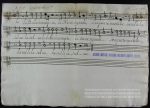
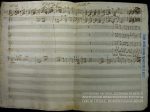
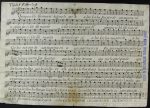
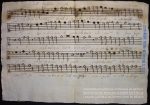
You must be logged in to post a comment.